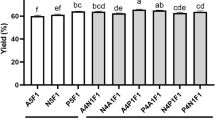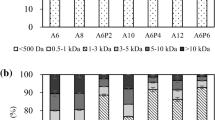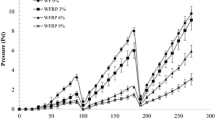Abstract
Wheat gluten was subjected to enzymatic hydrolysis with various proteases (Alcalase, Flavourzyme, Protamex) and the taste-enhancing properties and antioxidant activities of the resulting wheat gluten hydrolysates (WGHs) were characterized. The contents of the hydrophobic amino acid of the WGHs were highly correlated with the degree of hydrolysis by Flavourzyme and Protamex, except Alcalase. The taste profiles of the Alcalase-treated WGHs showed decreased bitterness while umami and overall acceptability increased. On the other hand, the WGHs produced by Flavourzyme and Protamex showed increased bitterness with increasing hydrolysis duration. However, taste profiles, such as umami, kokumi, and overall acceptability of the WGHs by Flavourzyme and Protamex were unaffected by the degree of hydrolysis. The WGH treated by Alcalase for 24 h (A24h) exhibited taste-enhancing property and its antioxidant effects were concentration-dependent. As a result, the A24h may be used as a multi-functional seasoning ingredient having potential antioxidant activity.





Similar content being viewed by others
References
Aaslyng MD, Martens M, Poll L, Nielsen PM, Flyge H, Larsen LM (1998) Chemical and sensory characterization of hydrolyzed vegetable protein, a savory flavoring. J Agric Food Chem 46:481–489
Adler-Nissen J (1979) Determination of the degree of hydrolysis of food protein hydrolysates by trinitrobenzenesulfonic acid. J Agric Food Chem 27:1256–1262
Chan KM, Decker EA (1994) Endogenous skeletal muscle antioxidants. Crit Rev Food Sci Nutr 34:403–426
Chang CY, Wu KC, Chiang SH (2007) Antioxidant properties and protein compositions of porcine hemoglobin hydrolysates. Food Chem 100:1537–1543
Chung SK, Osawa T, Kawakishi S (1997) Hydroxyl radical-scavenging effects of spices and scavengers from brown mustard (Brassica nigra). Biosci Biotechnol Biochem 61:118–123
Dunkel A, Koster J, Hofmann T (2007) Molecular and sensory characterization of γ-glutamyl peptides as key contributors to the kokumi taste of edible beans (Phaseolus vulgaris L.). J Agric Food Chem 55:6712–6719
Hedwig SC, Amado R (2002) Analysis of taste-active compounds in an enzymatic hydrolysate of deamidated wheat gluten. J Agric Food Chem 50:1515–1522
Humiski LM, Aluko RE (2007) Physicochemical and bitterness properties of enzymatic pea protein hydrolysates. J Food Sci 72:S605–S611
Indoh K, Nagata S, Kanzaki K, Shiiba K, Nishimura T (2006) Comparison of characteristics of fermented salmon fish sauce using wheat gluten Koji with those using soy sauce Koji. J Food Sci Technol Res 12:206–212
Kaneko S, Kumazawa K, Masuda H, Henze A, Hofmann T (2006) Molecular and sensory studies on the umami taste of Japanese green tea. J Agric Food Chem 54:2688–2694
Kong X, Zhou H, Qian H (2007) Enzymatic hydrolysis of wheat gluten by proteases and properties of the resulting hydrolysates. Food Chem 102:759–763
Kong X, Zhou H, Hua Y (2008) Preparation and antioxidant activity of wheat gluten hydrolysates (WGHs) using ultrafiltration membranes. J Sci Food Agric 88:920–926
Lee JS, Yoo MA, Koo SH, Baek HH, Lee HG (2008) Antioxidant and ACE inhibitory activities of soybean hydrolysates: effect of enzyme and the degree of hydrolysis. Food Sci Biotechnol 17:873–877
Li Y, Jiang B, Zhang T, Mu W, Liu J (2008) Antioxidant and free radical-scavenging activities of chickpea protein hydrolysate (CPH). Food Chem 106:444–450
Lioe HN, Takara K, Yasuda M (2006) Evaluation of peptide contribution to the intense umami taste of Japanese soy sauces. J Food Sci 71:S277–S283
Marcuse R (1960) Antioxidative effect of amino-acids. Nature 186:886–887
Nielsen PM, Petersen D, Dambmann C (2001) Improved method for determining food protein degree of hydrolysis. J Food Sci 66:642–646
Nishiwaki T, Yoshimizu S, Furuta M, Hayashi K (2002) Debittering of enzymatic hydrolysates using an aminopeptidase from the edible basidiomycete Grifola frondosa. J Biosci Bioeng 93:60–63
Noguch M, Arai S, Yamashita M, Kato H, Fujimaki M (1975) Isolation and identification of acidic oligopeptides occurring in a flavor potentiating fraction from a fish protein hydrolysate. J Agric Food Chem 23:49–53
Oyaizu M (1986) Studies on products of browning reaction: antioxidative activities of products of browning reaction prepared from glucosamine. Jpn J Nutr 44:307–315
Re R, Pellegrini N, Proteggente A, Pannala A, Yang M, Rice-Evans C (1999) Antioxidant activity applying an improved ABTS radical cation decolorization assay. Free Radic Biol Med 26:1231–1237
Sand J (2005) A short history of MSG. Gastronomica 5:38–49
Seo W, Lee HG, Baek HH (2008) Evaluation of bitterness in enzymatic hydrolysates of soy protein isolate by taste dilution analysis. J Food Sci 73:S41–S46
Shimada K, Funiko K, Yahara K, Nakamura T (1992) Antioxidative properties of xanthan on the autoxidation of soybean oil in cyclodextrin emulsion. J Agric Food Chem 40:945–948
Tang CH, Wang XS, Yang XQ (2009a) Enzymatic hydrolysis of hemp (Cannabis sativa L.) protein isolate by various proteases and antioxidant properties of the resulting hydrolysates. Food Chem 114:1484–1490
Tang CH, Peng J, Zhen DW, Chen Z (2009b) Physicochemical and antioxidant properties of buckwheat (Fagopyrum esculentum Moench) protein hydrolysates. Food Chem 115:672–678
Tang X, He Z, Dai Y, Xiong YL, Xie M, Chen J (2010) Peptide fractionation and free radical scavenging activity of zein hydrolysate. J Agric Food Chem 58:587–593
Toelstede S, Hofmann T (2009) Kokumi-active glutamyl peptides in cheeses and their biogeneration by penicillium roqyefortii. J Agric Food Chem 57:3738–3748
Toelstede S, Dunkel A, Hofmann T (2009) A Series of kokumi peptides impart the long-lasting mouthfulness of matured gouda cheese. J Agric Food Chem 57:1440–1448
Tomohiko Y (2006) Peptide with strong “kokumi” in fermented seasonings. Bio Ind 23:35–41
Ueda Y, Sakaguchi M, Hirayama K, Miyajima R, Kimizuka A (1990) Characteristic flavor constituents in water extract of garlic. Agric Biol Chem 54:163–169
Ueda Y, Yonemitsu M, Tsubuku T, Sakaguchi M, Miyajima R (1997) Flavor characteristics of glutathione in raw and cooked foodstuffs. Biosci Biotechnol Biochem 61:1977–1980
Wang JS, Zhao MM, Zhao QZ, Jiang YM (2007a) Antioxidant properties of papain hydrolysates of wheat gluten in different oxidation systems. Food Chem 101:1658–1663
Wang J, Zhao MM, Zhao QZ, Bao Y, Jiang YM (2007b) Characterization of hydrolysates derived from enzymatic hydrolysis of wheat gluten. J Food Sci 72:C103–C107
Yamaguchi N, Yokoo Y, Fujimaki M (1975) Studies on antioxidative activities of amino compounds on fats and oils. Part II. Antioxidative activities of dipeptides and their synergistic effects of tocopherol. J Jpn Soc Food Sci Technol 22:425–430
You L, Zhao M, Cui C, Zhao H, Yang B (2009) Effect of degree of hydrolysis on the antioxidant activity of loach (Misgurnus anguillicaudatus) protein hydrolysates. Innov Food Sci Emerg Tech 10:235–240
Zhu K, Zhou H, Qian H (2006) Antioxidant and free radical-scavenging activities of wheat germ protein hydrolysates (WGPH) prepared with Alcalase. Process Biochem 41:1296–1302
Acknowledgments
This research was supported by Technology Development Program for Food, Ministry for Food, Agriculture, Forestry and Fisheries, Republic of Korea.
Author information
Authors and Affiliations
Corresponding author
Rights and permissions
About this article
Cite this article
Koo, S.H., Bae, I.Y., Lee, S. et al. Evaluation of wheat gluten hydrolysates as taste-active compounds with antioxidant activity. J Food Sci Technol 51, 535–542 (2014). https://doi.org/10.1007/s13197-011-0515-9
Revised:
Accepted:
Published:
Issue Date:
DOI: https://doi.org/10.1007/s13197-011-0515-9




